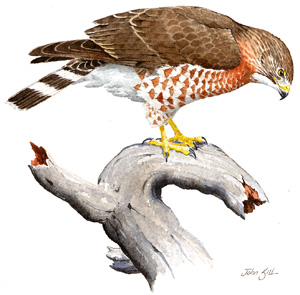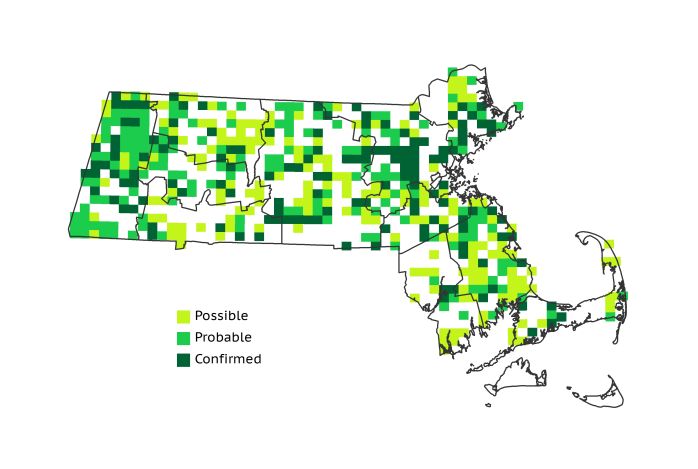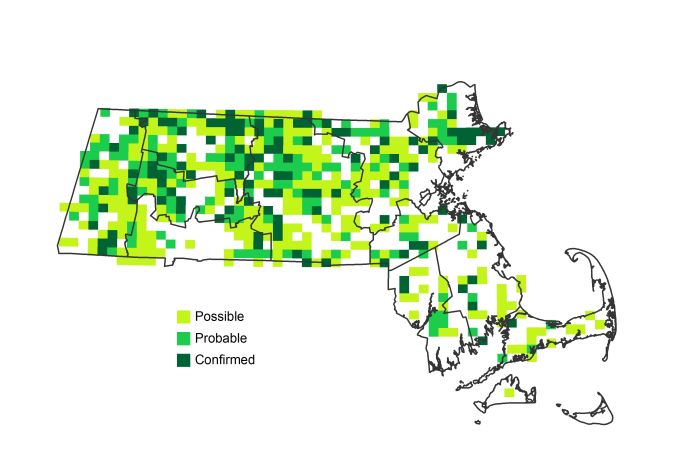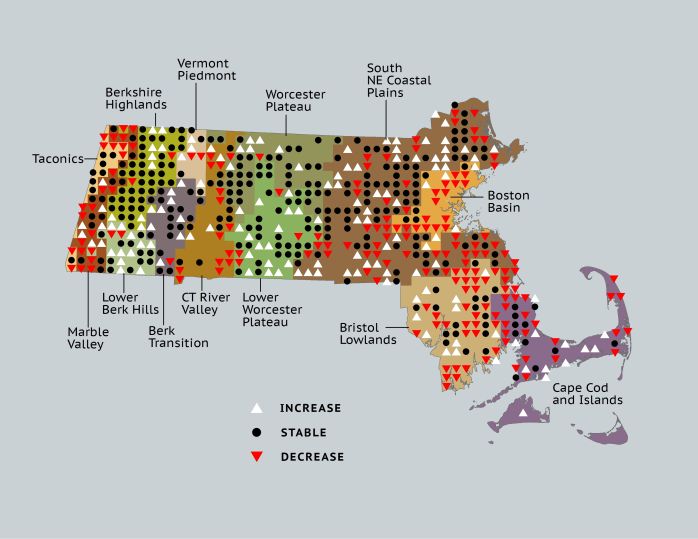Find a Bird
Broad-winged Hawk
Buteo platypterus

Widespread and likely declining
Action/monitoring needed
State Wildlife Action Plan listed
“Our birthdays are feathers in the broad wing of time.” Jean Paul Richter, Titan
As humans count their birthdays once a year, Broad-winged Hawks are famed for their fantastic specifically timed fall migration. Every autumn during a brief window in mid-September, thousands of Broad-winged Hawks can be seen soaring in “kettles” along the Appalachians as they head to Central and South America for the winter. These small buteos also breed all across the Bay State, preferring areas of mature forest habitat for nesting. The Broad-winged is among our longest distance migrant hawk species, and its recent decline may in part result from shooting and pesticide use on its tropical wintering grounds.
Historic Status
Like many forest-breeding birds in Massachusetts, Broad-winged Hawks witnessed their preferred habitat disappearing over the course of the first few centuries post-European settlement. Joel Asaph Allen, writing from Springfield, called them “rather rare summer residents” in the 1870s (Allen 1878). As agriculture spread, the Broad-winged Hawk retreated to the more forested sections of the state, including Plymouth and Bristol Counties (Forbush 1927). But it was not just the push of progress that took the birds’ breeding grounds away. Around 1900 a pernicious blight killed many of the American Chestnut trees that Broad-winged Hawks had long used for nesting (Forbush 1927). Reforestation during the twentieth century helped to bring the species out of hiding and once again into prominence in Massachusetts.
Atlas 1 Distribution
Broad-winged Hawks were a fairly widespread breeding species in the Commonwealth during the first Atlas. The Taconic Mountains and Marble Valleys had Broad-wings aplenty, as did the Berkshire Highlands region, but the southwestern part of the state and the Connecticut River Valley were more sparsely occupied. Broad-winged Hawks bred in half or more than half of all blocks in the Worcester and Lower Worcester Plateaus, and in just under half of the Coastal Plains. The Boston Basin and Bristol/ Narragansett Lowlands each had Broad-wing breeding activity, though less than in most westerly areas. Broad-winged Hawks were more local on Cape Cod and completely absent from the Islands.
Atlas 2 Distribution and Change
The results of Atlas 2 suggest that Broad-winged Hawks may be returning to their historic status as “rather rare” as they post notable declines in some ecoregions. The most western regions of the state, the Taconic Mountains and the Marble Valleys, both lost breeding Broad-winged Hawks in many more blocks than they gained. Moving eastward, Broad-winged Hawks were stable or even slightly increasing throughout most of the Berkshire regions, but the Connecticut River Valley told a different story. Broad-winged Hawks vanished from over 27% of blocks in that region and were newly found in only 8%. By contrast, the Worcester Plateau and Lower Worcester Plateau regions both had more gain than loss of Broad-wings between the two Atlases, and the center of the state is one area where the species remains quite widespread. The same could not be said for the eastern regions; though certainly still present in every region, Broad-winged Hawks showed negative trends in block occupancy in the Coastal Plains, Boston Basin, and Cape and Islands. The Bristol/Narragansett Lowlands show perhaps the most stark and notable loss of Broad-winged Hawks in the state, especially in Plymouth County.
Atlas 1 Map

Atlas 2 Map

Atlas Change Map

Ecoregion Data
Atlas 1 | Atlas 2 | Change | ||||||
Ecoregion | # Blocks | % Blocks | % of Range | # Blocks | % Blocks | % of Range | Change in # Blocks | Change in % Blocks |
Taconic Mountains | 15 | 93.8 | 3.1 | 10 | 40.0 | 1.9 | -7 | -46.7 |
Marble Valleys/Housatonic Valley | 30 | 76.9 | 6.2 | 21 | 53.8 | 4.0 | -9 | -23.1 |
Berkshire Highlands | 45 | 81.8 | 9.3 | 52 | 94.5 | 9.9 | 7 | 13.2 |
Lower Berkshire Hills | 15 | 53.6 | 3.1 | 26 | 83.9 | 4.9 | 8 | 29.6 |
Vermont Piedmont | 7 | 41.2 | 1.4 | 12 | 70.6 | 2.3 | 2 | 16.7 |
Berkshire Transition | 18 | 47.4 | 3.7 | 30 | 75.0 | 5.7 | 7 | 22.6 |
Connecticut River Valley | 24 | 42.9 | 5.0 | 18 | 27.7 | 3.4 | -9 | -18.8 |
Worcester Plateau | 45 | 57.7 | 9.3 | 80 | 90.9 | 15.2 | 9 | 18.8 |
Lower Worcester Plateau | 40 | 54.1 | 8.3 | 63 | 78.8 | 12.0 | 9 | 16.7 |
S. New England Coastal Plains and Hills | 140 | 51.9 | 28.9 | 147 | 51.9 | 27.9 | -11 | -4.9 |
Boston Basin | 20 | 35.7 | 4.1 | 11 | 19.6 | 2.1 | -9 | -16.4 |
Bristol and Narragansett Lowlands | 49 | 46.2 | 10.1 | 31 | 27.2 | 5.9 | -20 | -19.8 |
Cape Cod and Islands | 36 | 26.5 | 7.4 | 26 | 18.1 | 4.9 | -11 | -9.2 |
Statewide Total | 484 | 49.9 | 100.0 | 527 | 50.8 | 100.0 | -34 | -4.1 |
Notes
Despite losses in its Massachusetts distribution, the Broad-winged Hawk shows a significant increasing Breeding Bird Survey trend in the eastern US region.



